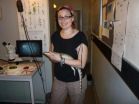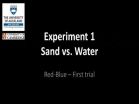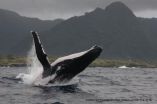(Press-News.org) Developing treatments that slow, if not halt, the neuronal loss and cognitive decline of Alzheimer's disease (AD) has proven to be a challenge. Among the scientists who have taken on that challenge are researchers at the University of Florida's McKnight Brain Institute in Gainesville, using the fruit fly Drosophila melanogaster as a model.
The scientists are investigating passive immunotherapy, one of the most promising approaches to blocking the amyloid-β42 (Aβ42) peptide, the main component of the amyloid plaques that damage the brain cells of patients with AD.
Monoclonal antibodies, the cornerstone of immunotherapy, do not easily penetrate the tightly packed cells of the blood–brain barrier. As alternatives to full antibodies, the University of Florida scientists generated transgenic flies expressing two anti-Aβ single chain variable fragments (scFv), known as scFv9 and scFv42.2.
Drosophila flies genetically modified to express human Aβ42 also co-expressed either scFv9 or scFv42.2. Each treatment reduced the loss of photoreceptor neurons due to Aβ42 toxicity and improved the insects' eye morphology. In addition, the flies' mushroom bodies, the brain structures involved in olfactory learning and memory, were protected.
Administering both scFv9 and scFv42.2 to the flies produced a synergistic protective activity, which suggests that both scFvs can simultaneously target different Aβ42 epitopes, the scientists said. This is the first time that two antibodies targeting different regions of Aβ42 have shown synergistic activities, thanks to the experimental flexibility of Drosophila.
In addition to immunotherapy, the scientists investigated the protective effects of a laboratory engineered secreted Heat shock protein 70 (secHsp70) on flies whose brain cells were accumulating Aβ42 extracellularly. Hsp70 is a chaperone that prevents and reverts protein misfolding but is primarily located inside the cell. In flies treated with extracellular secHsp70, the eyes were perfectly organized, cell death was reduced, calyces in the mushroom bodies were preserved, and locomotor function was improved.
The researchers determined that secHsp70 interacted directly with Aβ42 without affecting Aβ42 accumulation and aggregation in the flies' brains. Thus, the protective activity of secHsp70 may be mediated by stable binding to toxic Aβ42 species. This study is a new approach to broadly target amyloids outside the cell and block their ability to attack the surrounding neurons, the scientists said.
INFORMATION:
Abstract:
"Exploiting Drosophila as a platform to develop anti-amyloid strategies." Pedro Fernandez-Funez1,2, Jonantan Sanchez-Garcia1, Swati Khare1, Alfonso Martin-Peña1, Diego Rincon-Limas1,2. 1) Dept Neurology, Univ Florida, Gainesville, FL; 2) McKnight Brain Institute, Genetics Institute, and Center for Translational Research on Neurodegenerative Disorders.
Link:
http://abstracts.genetics-gsa.org/cgi-bin/dros14s/showdetail.pl?absno=14531635
ABOUT GSA:
Founded in 1931, the Genetics Society of America (GSA) is the professional scientific society for genetics researchers and educators. The Society's more than 5,000 members worldwide work to deepen our understanding of the living world by advancing the field of genetics, from the molecular to the population level. GSA promotes research and fosters communication through a number of GSA-‐sponsored conferences including regular meetings that focus on particular model organisms. GSA publishes two peer-‐reviewed, peer-edited scholarly journals: GENETICS, which has published high quality original research across the breadth of the field since 1916, and G3: Genes|Genomes|Genetics, an open-access journal launched in 2011 to disseminate high quality foundational research in genetics and genomics. The society also has a deep commitment to education and fostering the next generation of scholars in the field. For more information about GSA, please visit http://www.genetics-gsa.org. Also follow GSA on Facebook at facebook.com/GeneticsGSA and on Twitter@GeneticsGSA.
Immunotherapy approach to Alzheimer's studied in fly models
Immunotherapy approach to Alzheimer's studied in fly models Results reported at Drosophila Research Conference
2014-03-27
ELSE PRESS RELEASES FROM THIS DATE:
BMJ investigation: Public health funds raided to fill holes in local authority budgets
2014-03-27
A year after responsibility for public health was transferred from the NHS to local authorities, the BMJ found numerous examples of councils disinvesting in a wide range of public health services, including those for substance misuse, sexual health, smoking cessation, obesity, and school nursing.
Much of this money is being used to support wider council services vulnerable to cuts, such as trading standards, domestic abuse services, housing, parks and leisure centres.
The BMJ sent Freedom of Information requests to all 152 upper-tier local authorities in England, asking ...
NHS data on patient experience is often ignored
2014-03-27
On bmj.com today, Angela Coulter, Associate Professor at Oxford University and colleagues argue that this is "unethical" and call for a coordinated approach to use the information to help improve services.
Their views follow recent news of hospital trusts "helping" patients to write favourable reports of their experience of their services – and a report by Healthwatch England warning that the complaints system for the NHS in England is "hopelessly complicated" and needs an overhaul.
By April 2015, all NHS patients attending any type of healthcare facility in England ...
Stag beetle males give nasty nips despite massive jaws
2014-03-27
Armed with a ferocious pair of mandibles, male stag beetles appear well prepared to take on the world. 'Their jaws are not just for ornamentation, they really use them to fight', says Jana Goyens from the University of Antwerp, Belgium, adding that males grapple over the choicest patches of rotten wood for their mates to lay their eggs in. Describing a stag beetle battle, Goyens explains that one beetle grabs the other one around its body and then rears up in an attempt to hurl his opponent over his head and onto its back. 'It is clear which one is the loser', says Goyens. ...
Reproducible research, dynamic documents, and push-button publishing
2014-03-27
March 26, 2014, Hong Kong, China –The international open-access journal GigaScience (a BGI and BioMed Central journal) today announces a major step forward for reproducible research and public data-sharing in the neurosciences with the publication and release of a huge cache of electrophysiology data resources. Important for studying visual development, many groups have been using multielectrode array recordings to look at developmental changes and the effects of various genetic defects on the spontaneous activity of the retina. In neuroscience, public sharing of data is ...
Economic growth has little impact on reducing undernutrition in children
2014-03-27
A large study of child growth patterns in 36 developing countries published in The Lancet Global Health journal has found that, contrary to widely held beliefs, economic growth is at best associated with very small, and in some cases no declines in levels of stunting, underweight, and wasting. This suggests that investment in interventions that directly impact health and nutrition are needed to tackle child undernutrition.
Worldwide, malnutrition contributes to 2.6 million child deaths each year, or more than one in three of all child deaths. In 2011, an estimated 165 ...
Economic growth no cure for child undernutrition
2014-03-27
Boston, MA —A large study of child growth patterns in 36 developing countries finds that, contrary to widely held beliefs, economic growth has little to no effect on the nutritional status of the world's poorest children. The study, from researchers at Harvard School of Public Health (HSPH), the University of Göttingen, Germany, ETH Zürich, Switzerland, and the Indian Institute of Technology Gandhinagar, found that economic growth was associated with small or no declines in stunting, underweight, and wasting—all signs of undernutrition.
"These findings represent a potentially ...
Canal between ears helps alligators pinpoint sound
2014-03-27
By reptile standards, alligators are positively chatty. They are the most vocal of the non-avian reptiles and are known to be able to pinpoint the source of sounds with accuracy. But it wasn't clear exactly how they did it because they lack external auditory structures.
In a new study, an international team of biologists shows that the alligator's ear is strongly directional because of large, air-filled channels connecting the two middle ears. This configuration is similar in birds, which have an interaural canal that increases directionality.
"Mammals usually have ...
Cuvier's beaked whales set new breath-hold diving records
2014-03-26
Scientists monitored Cuvier's beaked whales' record-breaking dives to depths of nearly two miles below the ocean surface and some dives lasted for over two hours, according to results published March 26, 2014, in the open access journal PLOS ONE by Gregory Schorr from Cascadia Research Collective and colleagues.
Distributed throughout the world's oceans, the Cuvier's beaked whales' frequent dives deep into the ocean make them difficult for researchers to study. Previous studies using short-term tags (~ 215 hours of data) have indicated that this deep-diving species might ...
Crows complete basic 'Aesop's fable' task
2014-03-26
VIDEO:
This video shows example trials for each of the six experiments.
Click here for more information.
New Caledonian crows may understand how to displace water to receive a reward, with the causal understanding level of a 5-7 year-old child, according to results published March 26, 2014, in the open access journal PLOS ONE by Sarah Jelbert from University of Auckland and colleagues.
Understanding causal relationships between actions is a key feature of human cognition. However, ...
Humpback whale populations share core skin bacterial community
2014-03-26
Humpback whales share a simplistic skin bacterial community across populations, according to results published March 26, 2014, in the open access journal PLOS ONE by Amy Apprill from the Woods Hole Oceanographic Institution and colleagues. The overall bacterial communities differ by geographic area and by metabolic state, such as feeding versus starving during migration and breeding.
Bacterial communities living on mammal skin may play a role in their health; for humans, there is a relationship between skin bacteria and allergic or inflammatory conditions. While skin ...
LAST 30 PRESS RELEASES:
Post-stroke injection protects the brain in preclinical study
Cardiovascular risk score predicts multiple eye diseases
Health: estimated one in ten British adults used or interested in GLP-1 medications for weight loss
Exercise to treat depression yields similar results to therapy
Whooping cough vaccination for pregnant women strengthens babies’ immune system
Dramatic decline in new cases of orphanhood in Uganda driven by HIV treatment and prevention programs
Stopping weight loss drugs linked to weight regain and reversal of heart health markers
Higher intake of food preservatives linked to increased cancer risk
Mass General Brigham–developed cholera vaccine completes phase 1 trial
First experimental validation of a “150-year-old chemical common sense” direct visualization of the molecular structural changes in the ultrafast anthracene [4+4] photocycloaddition reaction
Lack of support for people on weight loss drugs leaves them vulnerable to nutritional deficiencies, say experts
Dogs’ dinners can have greater climate impact than owners’
Are you ready to swap salmon for sprats and sardines?
1.6 million UK adults used weight loss drugs in past year
American College of Cardiology comments on new dietary guidelines for Americans
American Society of Gene & Cell Therapy and Orphan Therapeutics Accelerator partner to advance and commercialize promising rare disease treatments
One in 14 patients having day case surgery have new or worse chronic pain 3 months after their operation
New study highlights link between eviction rates and gun violence
Heatwaves heat up soil but not toxin levels in rice, study finds
Digital modeling reveals where construction carbon emissions really come from
Turning farm waste into water filters
New study shows how the spleen helps the immune system accept a transplant
New Mayo Clinic study advances personalized prostate cancer education with an EHR-integrated AI agent
Researchers identify novel therapeutic target to improve recovery after nerve injury
Microbes in breast milk help populate infant gut microbiomes
Reprogramming immunity to rewrite the story of Type 1 diabetes
New tool narrows the search for ideal material structures
Artificial saliva containing sugarcane protein helps protect the teeth of patients with head and neck cancer
Understanding the role of linear ubiquitination in T-tubule biogenesis
Researchers identify urban atmosphere as primary reservoir of microplastics
[Press-News.org] Immunotherapy approach to Alzheimer's studied in fly modelsImmunotherapy approach to Alzheimer's studied in fly models Results reported at Drosophila Research Conference


